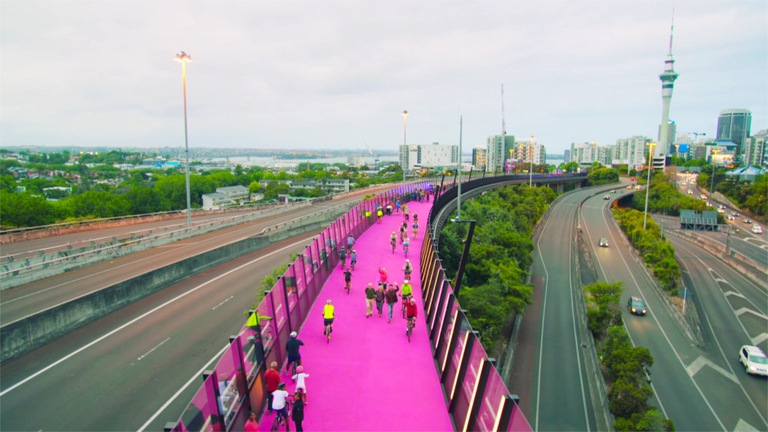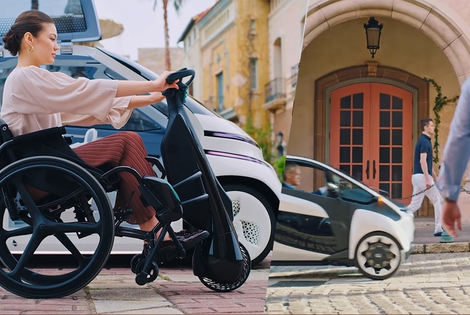
Milan has announced one of Europe’s most ambitious mobility schemes, known as Strade Aperte (open roads). Its goal is to reduce cars in phase 2 of the lockdown by increasing bike lanes and pedestrian areas.
The Nelson Street Cycleway in Auckland: its glass walls, LED mood lighting system and bright colours make this pink cycling lane visible at a great distance…and all over the world.
The pink cycling lane called Nelson Street Cycleway and known as “The pink bike path” or “The light path” has already become a must-see in New Zealand. It was built out of a disused off-ramp leading to Auckland’s State highway. Well, the view from the cycling lane is not spectacular, but now, thanks to this pink strip, cyclists and pedestrians can take a shortcut to get to the coast of the capital of New Zealand.
The Nelson Street Cycleway connects Upper Queen Street to Quay Street. The shared-use path will give access to the beach and become a crucial stretch of Auckland’s cycling network. The project has funding from the Government through the Urban Cycleways Programme and is being jointly delivered by the NZ Transport Agency, Auckland Council and Auckland Transport.
To be more precise the colour chosen for the path among different shades of orange, pink, yellow and red is a variety of purple called telemagenta.
The architects that planned the project explained that the choice of the colour was informed: they wanted it to stand out against the urban landscape and distinguish itself from other cycling paths, so they covered it with a bright pink resin. The architects chose telemagenta for their project because, according to them, many people wouldn’t dare use it and because it is a bright and easily visible colour that makes the cycling lane a sort of urban art installation.
The Nelson Street Cycleway is also lined on one side with three hundreds LED lights, which makes it even more original. The LED mood lighting system constantly changes and during the sunset it makes the path stand out even more.
Auckland’s pink cycling lane is also in the shortlist of Berlin’s World Architecture Festival in the section “transport”. In November it will compete with railway stations, ports, airports, bridges as well as with a cycling bridge built in the city of Odense, Denmark.
Siamo anche su WhatsApp. Segui il canale ufficiale LifeGate per restare aggiornata, aggiornato sulle ultime notizie e sulle nostre attività.
![]()
Quest'opera è distribuita con Licenza Creative Commons Attribuzione - Non commerciale - Non opere derivate 4.0 Internazionale.
Milan has announced one of Europe’s most ambitious mobility schemes, known as Strade Aperte (open roads). Its goal is to reduce cars in phase 2 of the lockdown by increasing bike lanes and pedestrian areas.
Formula 1, the world’s most important auto racing championship, has decided to turn the page and aim for carbon neutrality with the support of its teams, drivers and the whole racing circus.
Toyota and LifeGate began telling the story of hybrid mobility back in 2006, now, on the road to the Tokyo 2020 Olympics, they’re still treading the path of sustainable mobility. Here are the main steps of the journey.
Germany’s first solar bicycle lane could be the prototype for the roads of the future. The photovoltaic tiles melt snow and ice, and are capable of absorbing noise.
The Vespa is back in an electric version. Production has just started and the first models can be reserved online starting from October.
The city of Utrecht, in the Netherlands, is home to a bridge for cycling and walking that stretches over roof garden of a Montessori school. This project enhances practicality and will allow families to bring children to school by bike, passing through green areas. Despite their functionality, bridges are often seen as an infrastructure that is
The Lego hair bike helmet is the latest Internet craze. For now it’s just a prototype but production on a large scale will probably start soon.
Just as fires often give way to new growth, after the Dieselgate scandal, which saw Volkswagen cheating on US emission rules, the German car manufacturer radically changed course, beginning to focus on sustainable mobility. The German car company aims to propose thirty zero-emission models and produce at least one million battery electric vehicles by 2025. An ambitious mission
Sustainable, two-wheel mobility is triumphing in Copenhagen. After years of investments, policies, and infrastructural changes, bikes now outnumber cars in the city centre. The website Copenhagenize has released data linked to the number of vehicles entering the city centre, which are monitored by the city’s administration on a daily basis. Last year, 265,700 bikes have entered








